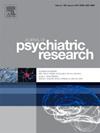Empirically informed symptom severity cutoffs for body dysmorphic disorder
IF 3.7
2区 医学
Q1 PSYCHIATRY
引用次数: 0
Abstract
Background
Symptom severity cutoffs for body dysmorphic disorder (BDD) are lacking, hindering communication between professionals and with the patient community.
Method
We pooled data from 11 clinical trials or high-quality cohort studies from specialist clinics, totaling 804 individuals with BDD (80 % girls/women, 67 % adults). All participants had baseline scores on the adult or adolescent versions of the Yale-Brown Obsessive-Compulsive Scale Modified for BDD (BDD-YBOCS) and the Clinical Global Impressions–Severity scale (CGI-S). Receiver-operating characteristic analyses were used to identify BDD-YBOCS severity cutoffs, using the CGI-S as the benchmark measure. The classification performance of the cutoffs was evaluated in a holdout sample, consisting of 20 % of randomly selected participants.
Results
No participants had subclinical symptoms and the cutoff for clinical versus subclinical cases was not computed. A BDD-YBOCS score ≥24 distinguished moderate from mild cases (area under the curve [AUC] = 0.72 [0.64–0.81]; accuracy: 77 %), a score ≥30 distinguished severe from moderate cases (AUC = 0.83 [0.90–0.87]; accuracy: 77 %), and a score ≥37 distinguished extreme from severe cases (AUC = 0.82 [0.77–0.87]; accuracy: 80 %). The classification performance of the cutoffs was modest in the holdout sample (62 %), but consistent cutoffs were found across sexes/genders, age groups (children and adults), and participants from Europe and the United States.
Conclusion
These BDD-YBOCS severity cutoffs can be used for clinical and research purposes across different populations but should not be used as the sole basis for important clinical decisions affecting individual patients. The boundary between subclinical and clinical BDD will require further study.
经验告知症状严重程度的切断身体畸形障碍
身体畸形障碍(BDD)的症状严重程度界限缺乏,阻碍了专业人员和患者群体之间的沟通。方法:我们汇集了来自11项临床试验或来自专科诊所的高质量队列研究的数据,共804名BDD患者(80%为女孩/妇女,67%为成年人)。所有参与者都有成人或青少年版的耶鲁-布朗强迫症修正量表(BDD- ybocs)和临床总体印象严重程度量表(CGI-S)的基线分数。使用CGI-S作为基准测量,使用接收器操作特征分析来识别BDD-YBOCS严重截止值。在一个由20%随机选择的参与者组成的拒绝样本中评估截止值的分类性能。结果没有参与者有亚临床症状,临床与亚临床病例的临界值没有计算。BDD-YBOCS评分≥24区分中度和轻度病例(曲线下面积[AUC] = 0.72 [0.64-0.81];准确率:77%),评分≥30区分重症和中度(AUC = 0.83 [0.90-0.87];准确率:77%),评分≥37区分极端病例和重症病例(AUC = 0.82 [0.77-0.87];准确度:80%)。截止点的分类表现在拒绝样本中是适度的(62%),但一致的截止点在性别/性别,年龄组(儿童和成人)以及来自欧洲和美国的参与者中被发现。结论这些BDD-YBOCS严重程度临界值可用于不同人群的临床和研究目的,但不应作为影响个体患者的重要临床决策的唯一依据。亚临床和临床BDD之间的界限需要进一步研究。
本文章由计算机程序翻译,如有差异,请以英文原文为准。
求助全文
约1分钟内获得全文
求助全文
来源期刊

Journal of psychiatric research
医学-精神病学
CiteScore
7.30
自引率
2.10%
发文量
622
审稿时长
130 days
期刊介绍:
Founded in 1961 to report on the latest work in psychiatry and cognate disciplines, the Journal of Psychiatric Research is dedicated to innovative and timely studies of four important areas of research:
(1) clinical studies of all disciplines relating to psychiatric illness, as well as normal human behaviour, including biochemical, physiological, genetic, environmental, social, psychological and epidemiological factors;
(2) basic studies pertaining to psychiatry in such fields as neuropsychopharmacology, neuroendocrinology, electrophysiology, genetics, experimental psychology and epidemiology;
(3) the growing application of clinical laboratory techniques in psychiatry, including imagery and spectroscopy of the brain, molecular biology and computer sciences;
 求助内容:
求助内容: 应助结果提醒方式:
应助结果提醒方式:


